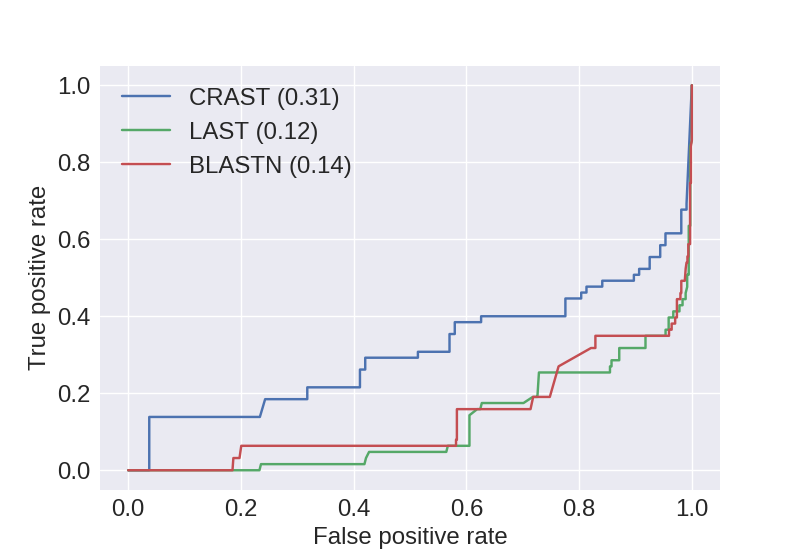# CRAST, Context RNA Alignment Search Tool
This binary provides the CRAST algorithm, a BLAST-like RNA alignment search one.
You can check all the available options by adding the option "-h".
A performance comparison of CRAST with other BLAST-like tools using all 18,185 house mouse ncRNAs/34 human lncRNAs known as homologs to house mouse corresponding ones as target/query sequences is as follows:
| CRAST | 65/107/0/0 | 0.548 | 160.0[m] | 148.0 (34.60) |
| LAST | 63/365/0/0 | 0.256 | 7.246 | 0.195 |
| BLASTN | 63/623/20/0 | 0.168 | 1.646 | 1.007 |
The "align. time" of CRAST inside the parentheses is time except for the pre-processing. (The "bzip2" decompression is time-consuming.)
The "TP" is map of any human one to any corresponding house mouse one; the "FP" is any human one to any of the others.
As a negative dataset, we made all the query ones di-nucleotide shuffled with UShuffle.
The "TN" is map of any shuffled query one to any of others than corresponding target ones; the "FN" is any shuffled query one to any of corresponding target ones.

The curves are derived from the above comparison using their alignment expectations as the thresholds.
Values inside the parentheses are areas under the curves. (The larger the area becomes, the better the prediction performance gets.)
# Dependencies
The dependency in this project is [the "bzip2" program](http://bzip.org/) (for database file compression).
You can install it in case of Ubuntu as follows:
```bash
$ sudo apt-get install bzip2
```
# Installation
This project has been written in Rust, a systems programming language.
So first you need to install the Rust compiler (Rustc), Rust package manager (Cargo) and Rust standard library.
Please visit [the Rust website](https://www.rust-lang.org) to see more about it.
You can install them with 1 line as follows:
```bash
The above installation is done by [Rustup](https://github.com/rust-lang-nursery/rustup.rs), so you can easily switch the compiler to use.
Now you can install CRAST as follows:
```bash
$ cargo install --git https://github.com/heartsh/crast
```
Check if it has been installed properly as follows:
```bash
$ crast-db && crast
```
If you're interested in how much fast it is, run the benchmark as follows:
```bash
$ git clone https://github.com/heartsh/crast && cd crast
$ tar xvf asts.tar.bz2
$ cargo test --release -- --nocapture
```
# Documents
[The CRAST document in English](dcs/crast_dc.pdf).
[The CRAST one in Japanese](dcs/crast_dc_4_jp.pdf).
[The CRAST thesis in BioRxiv](http://biorxiv.org/content/early/2017/04/15/127738).
# Trace of Experiments on Docker
If you're interested in demonstrated experiments in the thesis, you can trace them on a container deployed the [Docker](https://www.docker.com/) image "[heartsh/crast](https://hub.docker.com/r/heartsh/crast)" available on [Docker Hub](https://hub.docker.com/) into. (You can consider Docker Hub as Github for Docker.)
In advance, you need to enable GUI on Docker.
The process differs among Mac, Windows and Linux.
So we only explain about it on Mac, however, you could do it on the other platforms.
First install and start XQuartz and Socat as follows:
```bash
$ brew cask install xquartz
$ brew install socat
$ open -a XQuartz
$ socat TCP-LISTEN:6000,reuseaddr,fork UNIX-CLIENT:\"$DISPLAY\" &
```
Next, you need to know your PC's IP address as follows:
```bash
Now, you're ready for use of GUI on Docker.
After Docker installation, first run CRAST in the container as follows:
```bash
$ docker pull heartsh/crast # Pull image from Docker Hub
$ docker run -it -e DISPLAY=$IP_ADDRESS:0 heartsh/crast zsh # Deploy image into container and enter into it with login shell where variable "IP_ADDRESS" is your PC's IP address
$ git pull && tar xvf asts.tar.bz2 && cargo test --release -- --nocapture && cp ~/.cargo/bin/crast* /usr/local/bin # Run CRAST for test set
```
Then run the other BLAST-like tools and Foldalign following appendices in the thesis.
Note you need to prepend "##maf\n" into LAST outputs because without the file format identifier (it doesn't emit), the following process will fail.
In this point, you're ready for getting statistics in the thesis.
Try as follows:
```bash
$ ./gt_cmprsn_wth_blast_lk_tls.py
$ ./gt_cmprsn_wth_fldlgn.py
$ ./gt_crast_stts.py && okular asts/imgs/*.eps
```
# Author
[Heartsh](https://github.com/heartsh)
# License
Copyright (c) 2016 Heartsh
Licensed under [the MIT license](http://opensource.org/licenses/MIT).